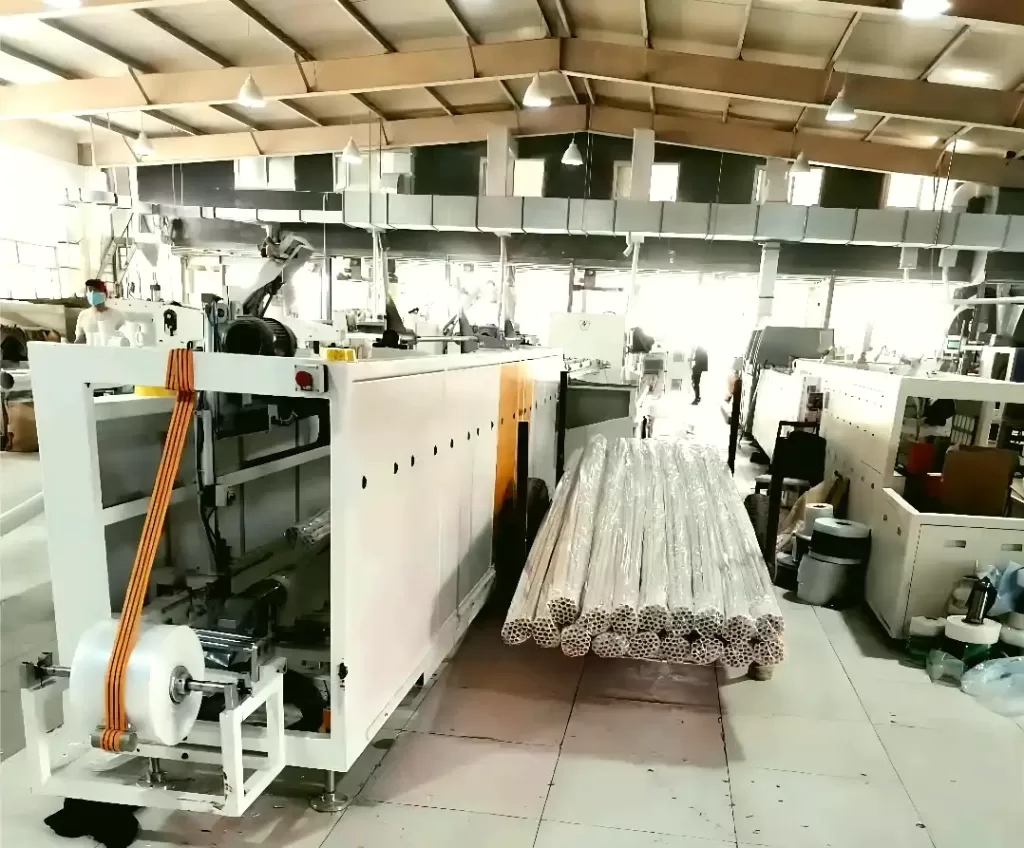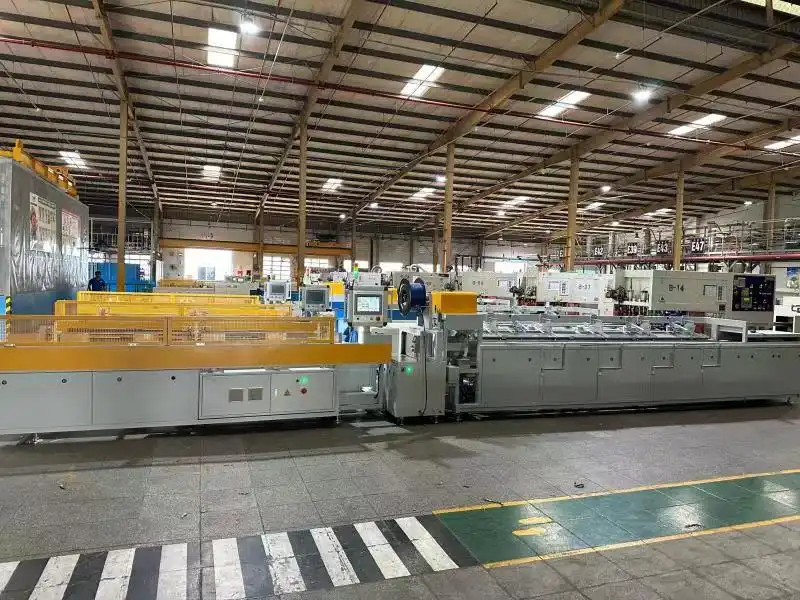The video showcases an automated carpet roll packing process, resulting in a securely sealed package covering the entire product.
Maximizing ROI: The Economic Benefits of Investing in Carpet Packing Machines
In the highly competitive landscape of the carpet industry, optimizing operational efficiency and managing costs are paramount for sustainable success. A key technological advancement aiding manufacturers and distributors is the automated carpet packing machine. Implementing this equipment offers significant economic advantages, making it a strategic investment for businesses seeking to enhance productivity, reduce waste, and improve profitability. This article explores the compelling financial and operational benefits of integrating carpet packing machines into your workflow.
Understanding Carpet Packing Machines
What is a Carpet Packing Machine?
A carpet packing machine is specialized industrial equipment engineered to automate the processes of rolling, wrapping, and packaging carpets. These systems typically handle various carpet sizes and types, applying protective film (like polyethylene) tightly around the roll. The primary function is to ensure carpets are securely packaged, shielding them from moisture, dirt, and physical damage during handling, storage, and transportation. Automating this crucial step significantly reduces manual labor requirements and boosts throughput.

Why are They Crucial in Today's Carpet Industry?
Manual carpet packing is often labor-intensive, slow, and prone to inconsistencies. Carpet packing machines address these challenges directly:
- Consistency: Automated wrapping ensures uniform tension and sealing, providing reliable protection for every roll.
- Speed: Machines operate significantly faster than manual methods, increasing overall plant capacity.
- Protection: Secure packaging minimizes costly damage, maintaining product integrity until it reaches the end customer.
- Labor Optimization: Frees up personnel for higher-value tasks within the facility.
As consumer expectations for product quality and delivery speed rise, efficient and protective packaging becomes a critical competitive differentiator.
Key Economic Advantages of Automated Carpet Packaging
Boosting Operational Efficiency and Throughput
Investing in a carpet packing machine directly translates to substantial gains in operational efficiency. Key improvements include:
- Increased Speed: Automated systems can process significantly more carpet rolls per hour compared to manual teams.
- Reduced Bottlenecks: Streamlining the packing stage prevents delays in the overall production or distribution workflow.
- Consistent Output: Machines operate reliably hour after hour, providing predictable throughput essential for planning and meeting deadlines.
- Minimized Downtime: Modern machines often feature robust designs and diagnostics to reduce unscheduled stops.
This heightened efficiency allows businesses to handle larger order volumes and meet tight delivery schedules without compromising packaging quality.

Significant Cost Savings and Strong Return on Investment (ROI)
Perhaps the most compelling economic argument is the potential for significant cost savings and a strong ROI:
- Reduced Labor Costs: Automation drastically cuts down the manual labor hours required for packing, leading to direct savings in wages, benefits, and associated overheads.
- Optimized Material Usage: Machines apply packaging film more consistently and efficiently than manual methods, often using less material per roll and reducing waste. Film saving can be up to 30% in some cases.
- Lower Damage-Related Costs: By providing superior protection, automated packaging minimizes product damage during transit and storage. This reduces costs associated with returns, replacements, and dissatisfied customers. ([Source example: Studies show packaging improvement can significantly cut logistics damage costs - reference a relevant logistics or packaging industry report if available]).
- Energy Efficiency: Many modern machines incorporate energy-saving features like variable speed drives and efficient heating elements (for shrink systems), lowering utility expenses compared to older or less optimized equipment.
While the initial capital expenditure exists, the cumulative savings typically result in a favorable ROI, often realized within a few years, depending on operational scale and machine utilization.
Reducing Product Damage and Enhancing Quality Perception
Improperly packaged carpets are susceptible to tears, punctures, moisture damage, dirt, and staining. Automated carpet wrapping machines apply protective layers precisely and securely, creating a robust barrier against these hazards.
- Uniform Tension: Ensures the wrap is tight enough to protect but not so tight as to damage carpet fibers.
- Complete Sealing: Many machines offer end-sealing or full encapsulation, preventing contaminants from entering the package.
- Professional Appearance: Consistently well-packaged products enhance brand image and customer perception of quality.
Reducing damage not only saves direct replacement costs but also protects brand reputation and improves customer satisfaction.
Leveraging Technological Advancements
Integration of Smart Technology and Automation
Contemporary carpet packing machines often incorporate smart features that enhance performance and integration:
- PLC Control: Programmable Logic Controllers allow for precise control over wrapping parameters (tension, overlap, cycles) and easy adjustment for different product specifications.
- Sensor Technology: Detects roll dimensions automatically, ensuring accurate film application and preventing collisions.
- Connectivity: Integration capabilities with Manufacturing Execution Systems (MES) or Warehouse Management Systems (WMS) allow for seamless data exchange and process automation across the facility. ([Source example: Industry 4.0 principles emphasize interconnectedness in manufacturing - link to a relevant article on smart factories or industrial automation]).
- Remote Diagnostics: Some models offer remote monitoring and troubleshooting support, minimizing downtime.
Customization and Operational Flexibility
Modern equipment offers significant customization and flexibility:
- Adjustable Parameters: Easily modify settings for different carpet widths, diameters, and types (e.g., residential vs. commercial grade).
- Film Compatibility: Designed to work with various types and thicknesses of packaging films.
- Modular Design: Some systems allow for adding features like automated labeling, weighing, or conveying integrations later.
This adaptability ensures the machine can handle a diverse product range and evolve with changing business needs.
Environmental and Sustainability Considerations
Supporting Eco-Friendly Packaging Practices
Sustainability is increasingly important. Carpet packing machines can contribute to greener operations:
- Material Reduction: Precise film application minimizes overuse and waste.
- Thinner Film Capability: Advanced tension control systems allow the use of thinner, high-performance films without sacrificing protection, reducing plastic consumption.
- Compatibility with Recyclable Films: Many machines are designed to handle recyclable polyethylene films, supporting circular economy goals.
Adopting sustainable packaging practices can enhance brand reputation and meet growing consumer and regulatory demands.
Focus on Energy Efficiency
Manufacturers are increasingly designing machines with energy efficiency in mind:
- Efficient Motors: Using high-efficiency or servo motors reduces electricity consumption.
- Optimized Heating (Shrink Systems): Improved insulation and precise temperature control minimize energy loss in shrink tunnels associated with some packing lines.
- Sleep/Standby Modes: Reduce power draw during idle periods.
Lower energy consumption directly reduces operational costs and contributes to a smaller environmental footprint.
Implementation Challenges and Considerations
Initial Investment and Financial Planning
The primary hurdle is often the initial capital investment. Businesses must conduct a thorough cost-benefit analysis, considering:
- Machine purchase price
- Installation and integration costs
- Potential facility modifications
- Long-term savings projections (labor, materials, damage reduction)
- Financing options and ROI calculation
A clear financial justification is essential for securing budget approval.
Workforce Training and Skill Development
Operating and maintaining automated equipment requires specific skills. Companies must plan for:
- Operator Training: Ensuring staff can safely and efficiently operate the machine, perform changeovers, and handle basic troubleshooting.
- Maintenance Training: Equipping maintenance personnel with the skills to perform preventative maintenance and repairs.
- Change Management: Addressing potential workforce concerns about automation and highlighting the shift towards higher-value roles.
Partnering with the equipment vendor for comprehensive training programs is often crucial.

Integration with Existing Production Lines
Seamless integration with existing infrastructure is key:
- Layout Compatibility: Ensuring the machine fits within the available floor space and aligns with existing conveyor systems or workflows.
- System Compatibility: Verifying that control systems can communicate with other plant automation systems if required.
- Installation Planning: Minimizing disruption to ongoing operations during the installation and commissioning phases.
Careful planning and coordination between internal teams and the equipment supplier are necessary.
Real-World Impact: Case Examples
Example 1: Large-Scale Carpet Manufacturer
A major North American carpet manufacturer integrated several automated packing lines. Results:
- Throughput Increase: Packing capacity increased by 40%.
- Labor Reduction: Reassigned 6 employees per shift from manual packing to other roles.
- Damage Rate Decrease: Reduced shipping damage claims by 20% within the first year due to improved package integrity.
- ROI: Achieved full return on investment in under 2.5 years.
Example 2: Regional Flooring Distributor
A mid-sized distribution center struggled with inconsistent packaging and high labor costs for its carpet segment. They installed a semi-automated carpet wrapping machine. Results:
- Efficiency Gain: Doubled the number of rolls processed per hour with the same staffing level.
- Material Savings: Reduced film consumption by 15% through consistent application.
- Improved Quality: Eliminated customer complaints related to packaging defects.
- Scalability: Enabled the distributor to handle increased volume during peak seasons without needing temporary labor.
Future Outlook: Innovations in Carpet Packaging
Advancements in Robotics and AI
The future points towards even greater automation:
- Robotic Integration: Robots for automatic loading and unloading of carpet rolls onto the packing machine.
- AI-Powered Optimization: Machine learning algorithms could potentially analyze sensor data to self-optimize wrapping parameters for maximum efficiency and film savings based on the specific carpet roll.
- Predictive Maintenance: Enhanced sensors and AI analyzing machine performance data to predict potential failures before they occur, maximizing uptime.
End-to-End Automation
The trend is towards integrating carpet packing seamlessly into fully automated warehouse and logistics systems, from production output to final shipment loading, minimizing manual touchpoints throughout the supply chain.

Conclusion: A Strategic Investment for Growth
Investing in an automated carpet packing machine presents a clear path toward enhanced economic performance for businesses in the carpet industry. The benefits – increased operational efficiency, significant cost reductions through labor and material savings, minimized product damage, and improved sustainability – provide a strong justification for adoption. While initial investment and integration require careful planning, the long-term advantages and rapid ROI potential position this technology as a strategic asset. By embracing automation in packaging, carpet manufacturers and distributors can strengthen their competitive position, improve profitability, and meet the evolving demands of the market effectively.